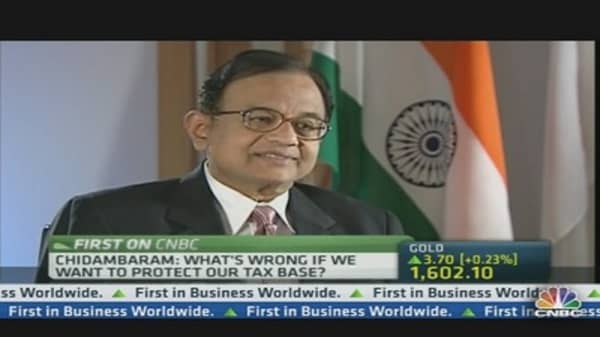Annual growth of 8 percent may seem like a distant memory in India, whose economy has suffered a sharp deceleration over the past year, however, the country's finance minister P. Chidambaram believes Asia's third largest economy can return to such levels by 2015.
"In 2013-14 we'll climb back to 6 percent plus and in 2014-15 I think we'll get back to 7-8 percent growth... we think we can grow at that rate for the next 20-25 years," Chidambaram told CNBC on Tuesday during a visit to Tokyo to promote India as an investment destination.
Gross domestic product (GDP) growth in India slumped to 4.5 percent during the fourth quarter of 2012 - its slowest pace in 15 quarters - a far cry from the stellar 8-9 percent growth rates seen last decade.
(Read More: India in a 'Horror Show' as Growth Slumps)
As a result, Chidambaram, who returned as finance minister in July last year, has taken several steps to boost investor confidence, from opening up sectors to foreign investment, to cutting subsidies to rein in the fiscal deficit.
Chidambaram added that monetary easing by the central bank, which has cut interest rates twice so far this year, is beginning to feed into increased economy activity. The Reserve Bank of India (RBI) is expected to lower borrowing rates further in 2013.
"I think at this time, there is perhaps still room for cutting rates, but that is a call the [RBI] governor has to take," he said.
"We see the beginnings of green shoots. There are more inquiries for loans, more project proposals. Stalled projects are being revived," he said. The government has also set a target of $1 trillion dollars for investments in infrastructure over the next five years.
(Read More: India Cuts Rates, Experts Say So What?)
In addition to efforts by the government and central bank to drive growth, he pointed to the country's robust savings rate as a major support for the economy. A higher savings rate translates into a larger pool of funds available for investment, which is positive for growth.
"In 2007-8 our savings were 36 percent of GDP. In the worst year, 2011-12, savings declined to 30 percent of GDP. 30 percent is not a number that can be dismissed easily - it's a very high level of savings," he said. In 2007-08, the economy expanded at a rate of 9 percent.
Managing the Deficit
Faced with a hefty current account deficit, which hit a record 6.7 percent of GDP in the three months to December, he said the country has to "redouble efforts" to attract foreign direct investment (FDI). "India can easily absorb $50 billion a year in FDI alone. Last year, we nearly had $46 billion of FDI," he said.
Chidambaram, however, said he is unlikely to further target gold consumption through additional import duties this year. Gold is India's second largest import after oil and has contributed to the expansion of the country's current account deficit. In January, the government increased the tax on its import to 6 percent, from an earlier 4 percent to curb demand.
(Read More: Indian Gold Imports Could Fall 25% on Duty Hike)
He said taxes on the import of the yellow metal are at an optimal level at the moment. "Evidence points out that if you raise tariffs too much it will increase smuggling."



